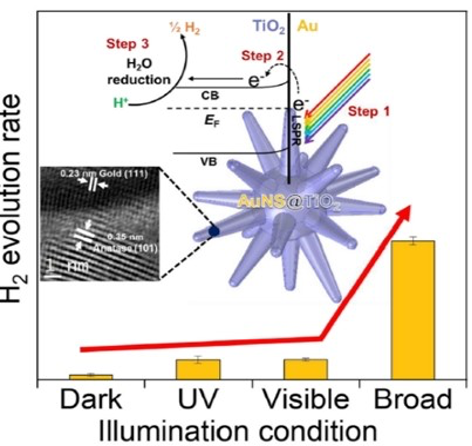

Invention Summary:
Nanoparticles such as gold nanospheres, nanorods and nanostars are a promising additive to titanium dioxide (TiO2) to increase photocatalytic efficiency. Conventional TiO2-nanoparticles are promising materials to drive photocatalytic reactions using light. However, they can only use UV wavelengths to promote reaction. There is a need for materials with enhanced photocatalytic capacity under visible or infrared light in addition to UV.
Rutgers researchers have developed a solution method to synthesize crystalline TiO2-coated gold nanostars at low-temperature, with the preservation of the nanostars delicate morphology. Under visible-near infrared illumination, TiO2-coated gold nanostars exhibited a significant increase in hydrogen production from water reduction compared to standard TiO2-coated nanoparticles and uncoated nanostars. This optimized TiO2-coated gold nanostar, when photoexcited with broad spectrum radiation, was capable of evolving >2500 μmol H2 per gram of catalyst in 20 min, which is 4x more efficient than commercially available TiO2 catalyts.
Advantages:
- High photocatalytic efficiency
- Low temperature synthesis
- Readily available materials for synthesis
Market Applications:
- Photocatalyst
- Solar and renewable energy
- Optical Antennas
- Water splitting
- Biosensor
Publications: Atta et al. Chem, 2018,4,2140-2153; Atta et al. Faraday Discuss., 2019,214,341-351
Intellectual Property & Development Status: US Patent number 62/836,805; 16/855,128. Available for licensing and/or search collaboration. For any business development and other collaborative partnerships contact marketingbd@research.rutgers.edu